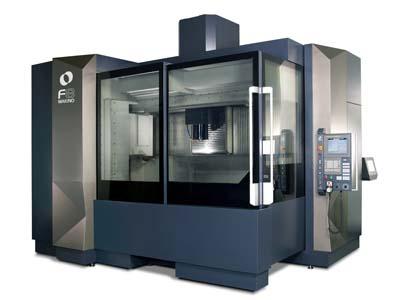
Makino expands its line of F-Series vertical machining centers with the new F8 (pictured) and F9. Large production parts present challenges due to the size and range of the part. Big die and mold components may test the work-weight capacity of most machines, and they could pose a unique dilemma for high-speed machining techniques and the accuracy capability. Designed for power, speed, precision and versatility, the F8 and F9 are builtto meet these divergent manufacturing needs in both the large part production and die and mold markets.
"The F8 and F9 offer hours of continuous, tight-tolerance machining at an outstanding value," said William Howard, Makino vertical product line manager. "Their robust design provides a versatile cutting platform that is ideal for both mold making and production machining. Standardly equipped with core-cooled ballscrews and scale feedback, the F8 and F9 offer a rare blend of precision, speed, capacity and flexibility to meet and exceed customer demands."
The smaller F8 features X-, Y- and Z-axis travels of 51.2 inches, 31.5 inches and 25.6 inches, respectively, a 61-inch-by-31.5-inch table and a maximum workpiece size of 61 inches long by 31.5 inches wide by 21.7 inches tall. By contrast, the larger F9 features X-, Y- and Z-axis travels of 63 inches, 31.5 inches and 25.6 inches, respectively, a 72.8-inch-by-31.5-inch table and a maximum workpiece size of 72.8 inches long by 31.5 inches wide by 21.7 inches tall. Both machines offer a payload capacity of 5,510 pounds and feature a 30-tool capacity automatic tool changer.
Changing full-size workpieces can dramatically impact large machine utilization, productivity and ultimately part costs. Therefore, the F8 and F9 incorporate a unique, dual sliding door, chip- and splash-guard design for simplified loading and unloading of large workpieces. The open-corner, open-ceiling design affordsunparalleled access for setups and changeovers, improving work in progress (WIP) and overall lead-times.
The F8 and F9 vertical machining centers offer a number of spindle configurations for tailoring the machine to specific die/mold or production applications.
The standard spindle configuration is a 49.6-hp, 10,000-rpm, CAT 50 spindle. As an option, the spindle can also be provided with an HSK-A100 spindle interface. With 315 ft-lbs of torque, this combination provides stiffness and rigidity for lower-speed roughing operations and an excellent mix of spindle speed, power and torque.
As an option, the F8 and F9 can be equipped with a 40.2-hp, 20,000-rpm, HSK-A63 spindle. This configuration provides the vibration-free, chatter-free, high-ranging spindle speeds required for efficient high-speed hardmilling of small details and fine surface finishes typical of the die/mold market.
The standard coolant system provides a combination of nozzle flood coolant, flush coolant, through-spindle air and an external air-blow nozzle. Dual internal spiral chip conveyors quickly and efficiently move chips and coolant to the rear of the machine, discharging them into a scraper-drum lift-up chip conveyor. Various, optional through-spindle coolant systems can be provided to further enhance the capability and performance of the machine.
The F8 and F9 vertical machining centers employ the Makino Professional 5 Control, which affords the perfect balance of a Windows CE graphical user interface (GUI), touch-screen selection offering instant access to information at one's fingertips, user-friendly, efficient PC-like capability for data management and editing, and the networking and storage capability of a data center.
As an option, the machine can be arranged with Makino's proprietary, next-generation Super Geometric Intelligence (SGI.4) software developed specifically for high-feedrate, tight-tolerance machining of complex, 3-D contoured shapes involving continuous, tiny blocks of NC data that ensure production rates faster than standard CNC systems while maintaining high accuracy. SGI.4 helps provide the lowest cycle times and costs achievable by reducing machining cycle times by as much as 40 percent when compared to most other control technologies.
Contact Details
Related Glossary Terms
- 3-D
3-D
Way of displaying real-world objects in a natural way by showing depth, height and width. This system uses the X, Y and Z axes.
- centers
centers
Cone-shaped pins that support a workpiece by one or two ends during machining. The centers fit into holes drilled in the workpiece ends. Centers that turn with the workpiece are called “live” centers; those that do not are called “dead” centers.
- computer numerical control ( CNC)
computer numerical control ( CNC)
Microprocessor-based controller dedicated to a machine tool that permits the creation or modification of parts. Programmed numerical control activates the machine’s servos and spindle drives and controls the various machining operations. See DNC, direct numerical control; NC, numerical control.
- coolant
coolant
Fluid that reduces temperature buildup at the tool/workpiece interface during machining. Normally takes the form of a liquid such as soluble or chemical mixtures (semisynthetic, synthetic) but can be pressurized air or other gas. Because of water’s ability to absorb great quantities of heat, it is widely used as a coolant and vehicle for various cutting compounds, with the water-to-compound ratio varying with the machining task. See cutting fluid; semisynthetic cutting fluid; soluble-oil cutting fluid; synthetic cutting fluid.
- numerical control ( NC)
numerical control ( NC)
Any controlled equipment that allows an operator to program its movement by entering a series of coded numbers and symbols. See CNC, computer numerical control; DNC, direct numerical control.
- payload ( workload)
payload ( workload)
Maximum load that the robot can handle safely.
- stiffness
stiffness
1. Ability of a material or part to resist elastic deflection. 2. The rate of stress with respect to strain; the greater the stress required to produce a given strain, the stiffer the material is said to be. See dynamic stiffness; static stiffness.

